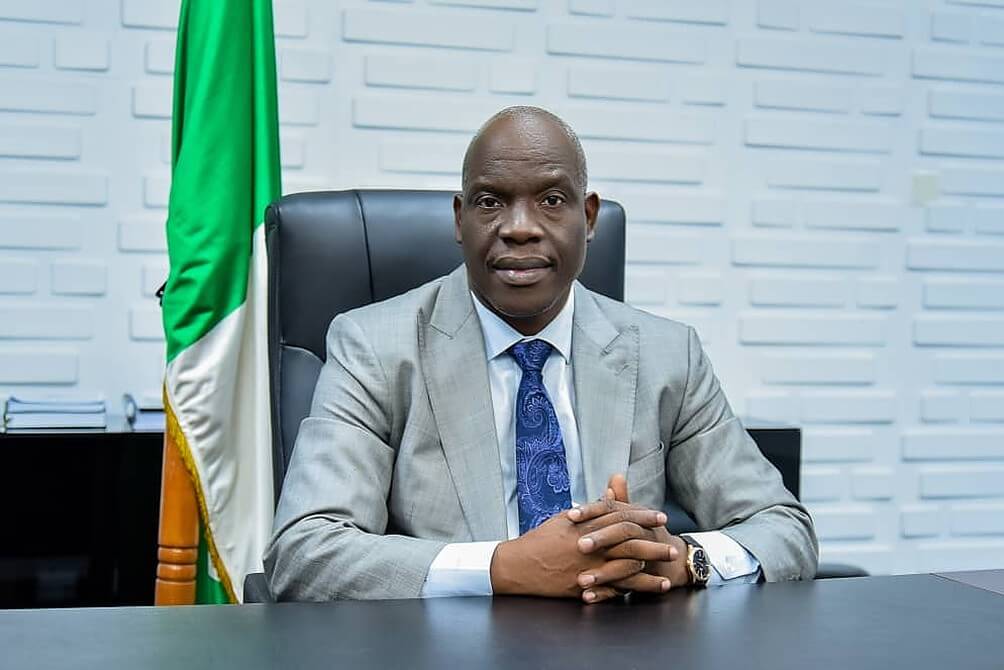NUPRC Woos Foreign Investors Into Nigeria’s Oil & Gas Industry, Says Operating Environment Safe
…As Oil Rigs Grow To 31 In August
The Chief Executive Officer of the Nigerian Upstream Petroleum Regulatory Commission, Gbenga Komolafe, has called on foreign investors to tap the opportunities of investing in Nigeria’s 223 open blocks which are up for investment bids.
Advertisement
Komolafe said this on Thursday at the 2023 Africa Oil Week (AOW) in Cape Town, South Africa with the theme, ‘Maximising Africa’s Natural Resources in the Global Energy Transition.’
He spoke on ‘Energy Transition Regime: Leveraging Investment Opportunities in the Nigerian Upstream Petroleum Sector.’
Komolafe disclosed that Nigeria has 395 oil blocks out of which 223 are open blocks. According to him, out of the 173 blocks, 61 are Oil Prospecting Licence (OPLs) while 112 are Oil Mining Licence (OMLs).
Out of the 223 open blocks, Deep Offshore blocks are 57; Continental Shelf has 7; Onshore Nigeria Delta 14; Anambra Basin 13 and the Benin Basin has 5 blocks.
Advertisement
Others are Benue Through which has 41; Bida 17; Chad Basin 40 and Sokoto 28 blocks.
He said, “Our drive to grow oil and gas reserves and boost production for energy security offers huge investment opportunities in exploration and development.
“But, alongside this are also huge investment opportunities for deployment of decarbonisation technologies to ensure environmental sustainability. To support this drive, the PIA mandates that only projects with gas utilization plan in the upstream sector will be approved or sanctioned.”
Global leaders committed to the Paris Agreement of 2015 and subsequent UN Climate Change Conferences, in which Nigeria actively participated. It requires countries to limit global temperature rise to within 1.5 °C – 2.0 °C of pre-industrial levels.
The rationale behind the net zero agenda is hinged on the impact of fossil fuels on the climate.
Advertisement
However, Nigeria and other African leaders seek a just and equitable energy transition in other to allow the continent to harness its oil and gas resources to fund its net zero target.
For Nigeria, 2060 will be the convenient time to transit fully, based on its energy transition plan.
As the push for net zero intensifies, the International Energy Agency’s (IEA’s) its World Energy Investment report indicates that “investment in clean energy technologies is significantly outpacing spending on fossil fuels’ as multinationals are divesting from oil and gas investments and embracing renewables.
With the rise of energy crises resulting from the Russia-Ukraine war, world leaders took a position on the matter which was re-echoed in the September 2023 G20 New Delhi summit during which the world leaders agreed that “national circumstances” will be factored into the phasing down of fossil fuels.
At the 78th session of the United Nations General Assembly, the global leaders agreed that “Transition must be just and equitable and address the needs of communities and economic actors who could potentially be left behind… The transition from fossil fuels to renewables would not be successful or sustainable without country-tailored financial instruments”.
Komolafe said the oil and gas industry in Nigeria has embraced the reality of green transition and environmental sustainability as envisioned in the Petroleum Industry Act, 2021 (PIA).
Advertisement
According to the NUPRC boss, investments have begun to improve in the country due to the fact that PIA has restored trust in the country’s oil and gas sector while the Nigerian Energy Transition Plan is gradually lowering carbon footprint compared to other fossil fuels.
Komolafe said based on the opportunities unlocked by the transition plan, Natural gas production is projected to increase from 8.0 billion cubic feet per day (bcfd) in 2020 to 12.2 bcfd in 2030 driven by major projects such as NLNG Train 7 & Train 8, Nigeria/Morocco pipeline, Ajaokuta-Kaduna-Kano (AKK) Natural Gas Pipeline Project.
He said, “On average, Nigeria had seventeen active oil rigs in 2019 representing one of the highest counts in the African continent as at then. The average rig count declined to eleven (11) in 2020, seven (7) in 2021, 10 in 2022, but recently grew to as high as thirty-one (31) by August 2023, a positive signal of new investments trickling into the country.”
The NUPRC boss reiterated the generous fiscal incentives in the PIA 2021, adding that investors are encouraged to leverage the incentives.
He said, “The incentives include: zero-hydrocarbon tax for deep water developments, reduced royalty rates based on production and terrains, and tax consolidation provisions amongst others.
“In the implementation of the PIA, the NUPRC has benchmarked our practices with the best international standards targeted at achieving: reduced unit cost per barrel; transparency in hydrocarbon accounting; operational efficiency; conducive operating environment; increase in oil and gas reserves and production and reduction in carbon footprint.”
He said efforts have been made in eliminating flared gas, arresting methane and other fugitive gas emissions, by commercializing forty-nine (flare sites through the Nigerian Gas Flare Commercialization Program (NGFCP), as part of Nigeria’s commitment to protect the environment.
He said, “The significance of this is that more gas would be available for domestic utilization as Liquefied Petroleum Gas (LPG), feedstock for power generation plants, fertilizer plants, petrochemicals and export.”



